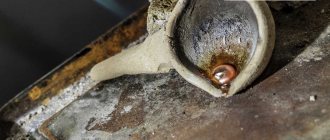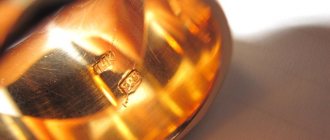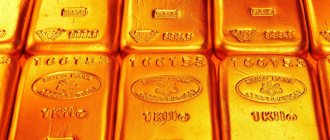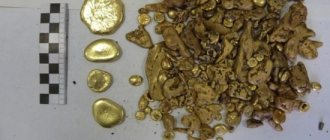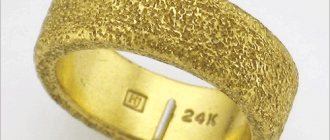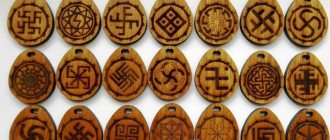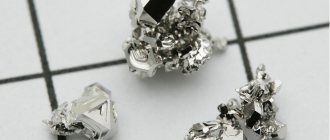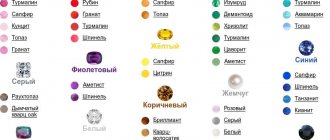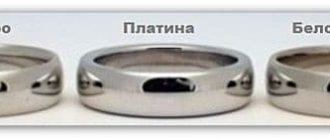Precious metals been counterfeited .
They spoiled the sample by adding an excessive amount of base metals to the gold alloy, creating that looked similar in appearance to noble aurum, but did not contain a single gram of gold.
Demand creates supply, and the demand for cheap imitation gold has always been great.
During the 19th and especially the 20th centuries, the “imitation industry” developed particularly rapidly.
Another example: there is also the so-called “white gold” - a gold alloy that is valued as highly as classic yellow, and in some cases even higher. But upon visual inspection, it is difficult white gold from silver or platinum .
Precious metal analyzers are designed to accurately determine from what metal or metal alloy a piece of jewelry is created, an ingot is cast, or a coin is minted.
The essence and purpose of the analyzer
A precious metal analyzer is a device designed to determine what metal a particular item is made of - a ring, coin, bar, etc.
The device determines the exact quantitative composition of various chemical elements in the product and shows the percentage of noble to base metals.
Simply put, a modern precious metals analyzer determines how much pure metal a given product contains:
- gold;
- silver;
- palladium;
- rhodium;
- other noble metals, and how many impurities (nickel, copper, zinc, chromium, etc.).
The sample size of the product
is determined by the ratio of gold or silver to the amount of impurities .
So, for example, the most common 585 gold standard in Russia contains 58.5% pure metal, and the rest is made up of impurities introduced to give the alloy greater strength, since pure gold is too soft.
Some devices immediately display the sample, others display a numerical code or the percentage of various metals on the screen, and the sample is determined by the appraiser using a special table.
Of course, if there are no precious metals in the product, the device will also show this.
How to choose a good tester?
If you need to buy a diamond tester, then you can use a few tips that will allow you to buy a really good device. First, make sure the device uses electrical conductivity to distinguish diamond from moissanite. The latest models available on the market combine testing with both heat and electricity for greater accuracy.
You also need to pay attention to whether the model has a metal detector that signals when the sensor accidentally touches the metal of the product. Otherwise, the results will not correspond to reality.
Operating principles of the device
From a design point of view, a precious metals analyzer is a highly specialized metal detector, similar to those used in other areas, for example, in rolled metal.
Only it is certified and tailored for the detection and recognition not of iron and carbon in a steel alloy, and not of copper and tin in a bronze alloy, but of precious metals : gold, silver, platinum in combination with various possible additives.
Only non-destructive testing can be used to check the quality of jewelry. This places restrictions on the physicochemical methods that can be used for research.
This is quite logical - you can’t spoil the product by separating fragments from it for chemical tests.
At the moment, two operating principles are used to create precious metal analyzers: X-ray fluorescence and electrochemical.
X-ray fluorescence
This method is based on exposing an object to low-power X-ray radiation using an artificial or natural source.
Early devices used natural materials - plutonium-238, iron-55, etc. Nowadays artificial ones are used more often.
The radiation power is so low that it cannot harm a person even with prolonged use of the device.
A stream of X-ray radiation “hits” an object, causing it to respond in the X-ray spectrum invisible to the human eye. The induced learning response, which is a flow of electrons, is detected by a highly sensitive sensor. This is fluorescence.
Each chemical element produces its own characteristic “glow” in the corresponding spectrum. The higher the content of a substance, the more powerful it will fluoresce.
A special program analyzes the total spectrum of radiation and determines the percentage of different metals with a high degree of accuracy - up to 0.1%. Each metal requires an individual program .
Another name for this device is an energy-dispersive detector, or spectrometer.
Electrochemical analysis
This method uses an electrochemical reaction that occurs when a metal comes into contact with an electrolyte - sulfuric or hydrochloric acid diluted in water.
The idea of this method is that each metal has its own, unique electrical conductivity parameters .
When checking with this device, a conductive contact from the analyzer is attached to the jewelry.
The second contact is combined with a sensor, which, in turn, is combined with a container containing electrolyte.
A drop of electrolyte is squeezed onto the surface of the product .
Immediately after this, an electrochemical reaction - some of the electrons pass into the electrolyte. In this case, it becomes possible to determine the metal from which the product is made by its electrical conductivity.
Electrical conductivity is determined by the voltage that occurs at the point of contact of the electrolyte spot and the metal surface of the product.
To determine the exact chemical composition of a substance, comparison with a standard made of platinum is used . Platinum is usually used to make one of the electrodes.
This method also requires special firmware in the device's memory. At the moment it is considered obsolete , although a large number of electrochemical detectors are still used in various departments of the Assay Office, at customs special posts, in pawn shops, etc.
The operating principle of diamond testers.
The operating principle of this device is based on the characteristics of thermal conductivity. Different stones conduct heat differently, this is due to the characteristics of their structure. Diamond transmits heat differently than cubic zirconia or glass. Moreover, cubic zirconia and glass are most often used for diamonds. A diamond tester senses how heat moves through the stone and compares the result to a predetermined value. If the diamond is real, the tester will immediately detect it. There are also testers that use electrical conductivity instead of thermal conductivity.
How to analyze gold and other precious metals with a detector?
It all depends on the principle on which the analyzer is built and its design. The easiest to handle is a handheld spectrometer, which is similar to a handheld scanner used in stores.
It is necessary to set the expected metal in the settings (i.e., select what we will test for), enter additional parameters (in some models) - this could be, for example, the “white gold” setting, so that the device initially excludes some impurities that are impossible in it.
After this, you need to
point the detector emitter at the product and wait for some time - 15-20 seconds.
After this, information about the chemical composition of the object under study will appear on the screen.
It is more difficult to work with stationary devices, especially those that operate on the electrochemical principle.
This requires certain knowledge.
Before starting to operate the device you must:
- calibrate;
- set the correct mode;
- correctly connect the contacts to the test sample.
What are diamond testers used for?
Diamond testers are used by jewelers who constantly work with jewelry. In the event that a diamond needs to be sold or exchanged, the jeweler will first want to verify its authenticity because this is not always obvious. Also, to repair or rework a piece of jewelry, the craftsman needs to know exactly which stone is set in the setting, since different stones have different resistance to temperature, pressure or stress. It will be helpful for the client to see how the jeweler who restored the jewelry inspects it before returning it.
If the authenticity of the stone is in doubt, you can go to any jewelry store or workshop and check the diamond for an additional fee.
Review of detectors for checking precious metals and their price
For comparison, we will take three models - two domestic and one foreign-made.
This:
- "Prizma-M" produced by the Granat Group of Companies.
- Gold detector "DeMon-Yu" produced by "Ultramag".
- "GoldXpert" produced by a Japanese company
The Prizma-M analyzer from the St. Petersburg group is a professional device recommended for state assay offices, customs posts, pawn shops, etc.
The principle of operation is X-ray fluorescence.
Type - stationary, portable type.
To scan a product, you need to place it in a special chamber of the device.
The Prizma-M gold detector also determines silver, palladium, rhodium, platinum and the content of various impurities in them in concentrations of up to 0.1%.
Total weight - 11 kg. Battery life is up to 2 hours. A large number of modes provide flexibility in setting up the product.
Prices available on request. Approximately - within 100,000 rubles .
The DeMon-U
detector is a portable device for determining the sample of gold and other precious metals, operating on the electrochemical principle.
It is completed with electrodes, a probe-sensor and a container with electrolyte.
The device is able to recognize gold, silver, palladium and platinum of the most common samples. It has 2 main working programs - for white and yellow metals.
According to its characteristics, this is a tester that is intended only to determine the authenticity of a sample of jewelry. Its exact chemical composition is not shown.
Cost - 21,000 rubles .
A device for testing gold and more “GoldXpert” is professional equipment made in Japan, using the spectroscopy method.
With basic firmware it is able to detect and identify 25 different precious and base metals, including all metals classified as precious.
Identifies elements from silver to iridium and osmium, and a large number of others, including:
- copper;
- iron;
- zinc;
- lead;
- manganese;
- nickel;
- cobalt and others.
Structurally, in terms of dimensions and weight, it is similar to the Prizma-M device. The cost is also available upon request and is approximately comparable to the price of the domestic analogue.
Diamond tester
Each material has its own thermal conductivity. Materials also differ in their reflective properties. While glass and a cut diamond are similar in appearance, they differ in the indicated indicators. A diamond authenticity tester is designed to determine the differences . The device is also called a “diamond tester”. The word "diamond" is translated as "diamond". The technology is able to recognize a real diamond not only in a row of glass, but also among artificially grown crystals and minerals that outwardly resemble the “king of stones.”
If a diamond tester relies on the thermal conductivity of materials, there may be errors in determining the authenticity of the stone. There is one “twin” of diamond with the same thermal conductivity. This is a man-made moissanite stone. Scientists synthesized it following a program to create non-natural diamonds. The mineral is, indeed, more than 90 percent similar to the prototype. Hardness is only 0.75 points worse than diamond on the Mohs scale, and thermal conductivity is exactly the same.
Devices that pay attention to the refractive index of light can eliminate all imitations of jewelry. For the same moissanite, for example, it is greater than that of a diamond. However, the second type of testers can only work with polished surfaces, that is, with processed crystals. If you submit an ordinary nugget for testing, without polishing, the technique will not produce results.
There are also combined models of testers, with the installation of both thermal and light receptors. For example, the GemOro brand is known for its universal samples. According to statistics, most jewelry chains and individual entrepreneurs purchase American brand products. Samples from US companies cost from 7 thousand rubles. For comparison, a Chinese-made pocket tester for personal use that determines thermal conductivity costs customers only 600-700 rubles. Identification, manufacturers say, occurs instantly. You just need to bring the device to the stone.
Typically, testers provide light signals. Thus, in the professional model “Gem Oro Ultra TesterR” the diamond is indicated by a green indicator. If the sample being tested is moissanite, the light turns blue. The device reacts to metal objects with a red signal.
In offers to buy a diamond tester, the “guarantee” line may or may not appear. The maximum service period by the manufacturer is 1 year. The devices operate on batteries or rechargeable batteries. Charging stations are included. Most testers are capable of working with crystals of various sizes, even very large ones. The size of the “spout” to which the sample is brought is adjustable. The main thing is to wipe the mineral with a napkin first, otherwise the instrument readings may be inaccurate.
Only a few testers can give the most accurate research result. Professionals have gotten used to purchasing two or three of the most reliable devices. The three most popular among specialists are “Diamond Sure”, “Diamond View” and “Diamond Plus”. The first model on the list is based on light absorption. The second sample studies the luminescence of diamonds. The third option is highly sensitive to photoluminescence. The complete set costs almost 50 thousand dollars. Only for this money you can be more than 90% sure of the result.
Contrary to advertising claims, not a single tester gives a one hundred percent guarantee, jewelers and geologists note. For an absolute guarantee, you must contact a special gemological laboratory. But, since many deals need to be concluded here and now, testers are also indispensable. No one will hand the stone over to the wrong hands for a couple of weeks so that they can take it down for examination. Handy devices help out. Even if they do not provide a 100% guarantee, they significantly reduce the risks.
As for the budget models of diamond testers, priced at several tens of dollars, the line of models of the Presidium brand earned especially angry reviews from mineralogy experts. Devices with this marking determine the origin of the stone with a 50/50 probability. In other words, according to the theory of probability, a sample is either a diamond or it is not. This can be predicted without any technology.
To be fair, it is worth noting that there are additional tests for the origin of, for example, diamonds. The simplest device helps - a magnifying glass. It costs a penny, but the results are good. For example, if even the smallest inclusions are not detected in a crystal under 20X magnification, the stone is probably artificial. Natural diamonds are not perfectly pure. Forming in the deep layers of the Earth, under high pressure, next to other elements and rocks, minerals, one way or another, capture air bubbles and foreign particles.
A regular magnet will also come in handy when purchasing a diamond. 90-95 synthetic stones out of 100 react to it. In the case of attraction to magnetic iron ore, the mineral is probably artificially grown. Of course, you can only check a single crystal. If it were encased in metal, the test would become impossible.
Another classic tester is a microscope. Natural stones are almost always mono, that is, single crystals. Samples obtained in laboratories are grainy. This can be seen under magnification. Diamonds seem to be assembled from many smaller crystals.
How to choose the right tester
To make the right choice in favor of a high-quality diamond tester, pay attention to the main operating principle of the device; Make sure the tester is capable of determining the thermal conductivity of materials. In order to most accurately distinguish natural stone from fake, testers are now being produced that determine both thermal conductivity and electrical conductivity. It is also better to choose a diamond tester model with a metal detector. Such a tester will signal if during testing you accidentally touch a metal part of the jewelry. This will help eliminate measurement errors.
This is interesting! How to distinguish between different types of cuts. Comparison of diamond cuts
Analyzer: what is it and what is it intended for?
At its core, a precious metal analyzer is designed as a device necessary to determine the composition of a product - a piece of paper, a coin, a ring, etc. It calculates the exact composition of the various components, showing in what percentage noble metals are present. A high-tech analyzer reveals how much pure substance is present in an object:
- Silver;
- Gold;
- Rhodia;
- Palladium;
- Other noble metals;
- Third-party impurities: copper, nickel, zinc, chromium and others.
For example, on Russian territory, 585 gold is most widely used, containing 58.5% pure metal, and the rest consists of impurities that are introduced to give it strength, because in its pure form gold is soft and ductile.
There are models of devices that are able to immediately display the sample, others display only numerical codes or percentages of components on the screen, and the appraiser has to check the table to determine the sample. Of course, if there are no precious metals in the product, then this will also be visible from the readings of the device.

